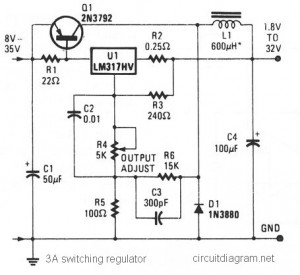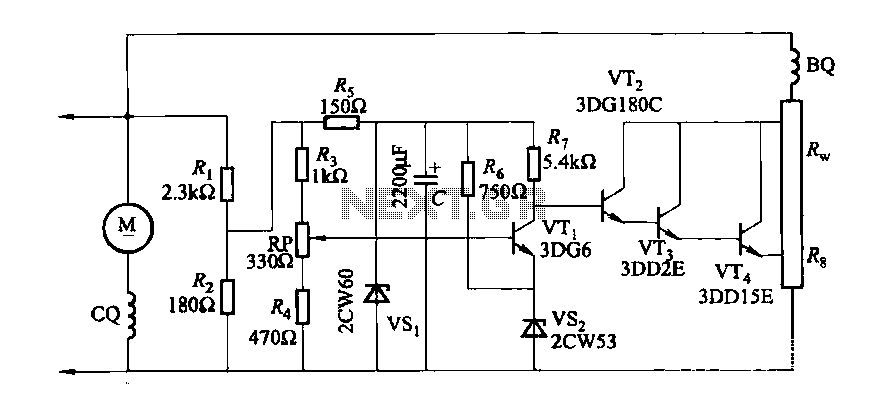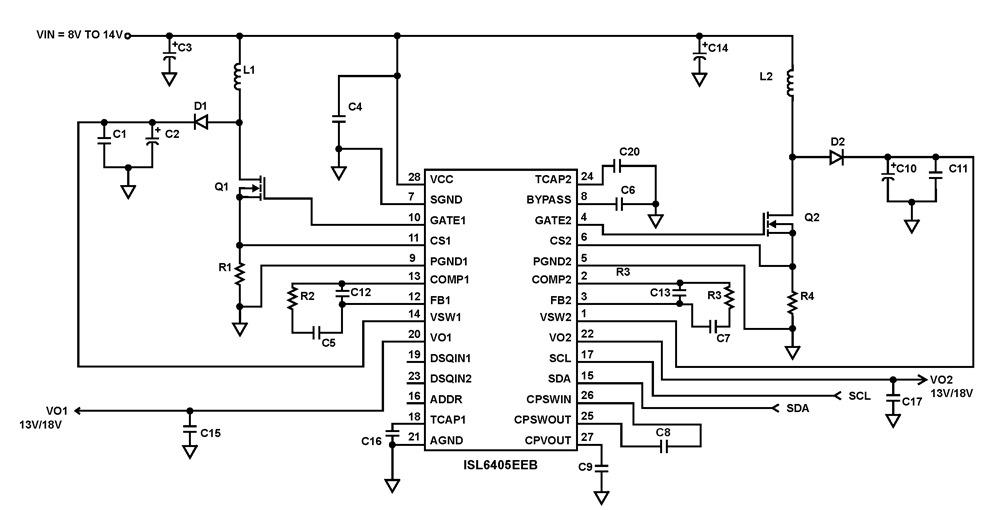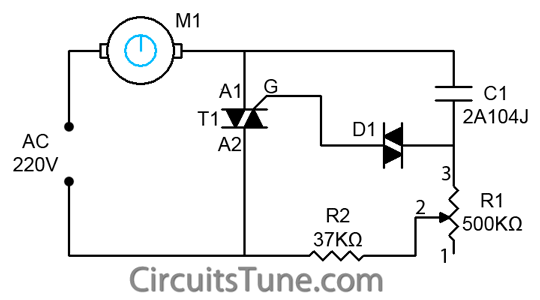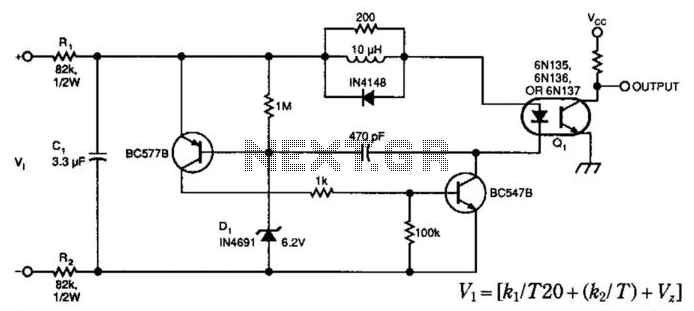
thrifty voltage regulator

One of the drawbacks of a three-pin voltage regulator is that the input voltage needs to be 2.5 to 3 V higher than the output voltage. This makes these integrated regulators unsuitable for battery power supplies. For instance, if the output voltage is 5 V, a 9 V battery could be discharged to approximately 7.5 V. Additionally, most of these regulators draw a current of about 2 mA. Special low-drop versions sometimes offer a solution, but they are not ideal either. The regulator described here is more efficient: it draws a current of only 300 µA, and the difference between its input and output is only 100 to 200 mV. In the circuit diagram, T1 is configured as a series regulator, meaning that the difference between input voltage and output voltage is limited to the transistor's saturation potential. Therefore, a 9 V battery can be discharged to about 5 V, which is a significant improvement over the situation with an integrated regulator. Diodes D1, D2, and D3, or a suitable zener diode (D4), along with R5 and P1, form a variable reference voltage source that serves as the output-dependent base potential of T3. If the output voltage drops below a desired level, the base potential of T3 also decreases. Consequently, the transistor conducts less, causing its collector voltage to rise. This increase in base voltage of T2 drives T1 harder, leading to the near-instantaneous restoration of the output voltage. The design of the reference voltage source is crucial. The current through the LEDs or the zener diode is approximately 100 µA, resulting in a drop across a 5.1 V zener diode of only 4.3 V and across each LED of about 1.43 V. For a target output voltage of 4.8 V, the three LEDs proved very effective, whereas the zener diode did not. If a zener diode is used, one rated at 4.7 V may be necessary. For an output voltage of 5 V, careful selection of the zener diode is required. When the battery voltage drops to a level just above the desired output voltage, T1 and T2 conduct heavily. A further decrease in battery voltage will cause the collector potential of T2 to drop rapidly to 0 V, as T2 attempts to make T1 conduct harder. This significant drop in the collector potential of T2 can be used to drive a BATT-LOW indicator. This can be achieved in three ways as illustrated in Figure 2. When network A is connected between terminals A and B, transistor T4 will typically be held off by divider R6-R7a. If the voltage at B drops suddenly, T4 conducts, and D5 indicates that the battery is nearly depleted. Network B is similar to A but is designed for a liquid-crystal display of BATT-LOW. The collector of T4 connects to the IC that drives the decimal point and the BATT-LOW segment of the display. Network C can be utilized if there is an unused inverter or gate in the powered circuit. The high value of resistor R7b prevents damage to the internal protection diodes of the IC. Upon building the regulator, it should be connected to a variable power supply via a multimeter set to the mA range, and P1 should be set roughly at its mid-position. P1 should then be adjusted slowly until the desired output voltage is achieved. If the regulator draws more than 250 to 300 µA at an output voltage of 4.8 V, the three LEDs or the zener diode must be replaced. The regulator can supply a current of up to approximately 25 mA. With a fresh 9 V battery, the dissipation of T1 does not exceed 100 mW. If the input voltage is higher, it may be necessary to mount the transistor on a suitable heat sink or replace it with a power transistor, such as a Type BD138.
The described voltage regulator circuit efficiently manages output voltage with minimal input-output voltage differential, making it suitable for battery-operated devices. The use of a series transistor configuration allows for improved performance, enabling the regulator to function effectively even as the battery discharges. The feedback mechanism involving T3, T1, and T2 ensures rapid response to voltage drops, maintaining stable output levels. The incorporation of diodes and resistors to create a variable reference voltage is essential for the regulator's operation, particularly in ensuring that the output voltage remains within the desired range. The design considerations for the zener diode or LED reference voltage source are critical, as they directly influence the regulator's efficiency and performance. The circuit's ability to indicate low battery status through various configurations of transistor T4 enhances its usability in practical applications. Overall, the design balances efficiency, responsiveness, and reliability, making it a valuable component for low-power electronic systems.One of the drawbacks of a three-pin voltage regulator is that the input voltage needs to be 2. 5 3 V higher than the output voltage. This makes these integrated regulators unsuitable for battery power supplies. If, for instance, the output voltage is 5 V, a 9 V battery could be discharged to 7. 5 V or thereabouts only. On top of this, most of these regulators draw a current of about 2 mA. Special low-drop versions sometimes offer a solution, but they are not ideal either. The regulator described here is rather thriftier: it draws a current of only 300 µA and the difference between its input and output is only 100 200 mV In the circuit diagram, T1 is arranged as a series regulator, which means that the difference between input voltage and output voltage is limited to the transistor`s saturation potential. Therefore, a 9 V battery can be discharged to about 5 V, which is quite an improvement on the situation with an integrated regulator.
Diodes D1-D2-D3, or a suitable zener diode (D4), in conjunction with R5 and P1, form a variable reference voltage source, which is used as the (output-dependent) base potential of T3. If the output voltage drops below a desired level, the base potential of T3 also drops. The transistor then conducts less hard and its collector voltage rises. The base voltage of T2 also rises, so that T1 is driven harder. This results in the near-instantaneous restoration of the output voltage. The design of the reference voltage source is clearly of paramount importance. The current through the LEDs or the zener diode is of the order of only 100 µA. This means that thedrop across a 5. 1 V zener diode is only 4. 3 V and across each LED, only about 1. 43 V. For a wanted output voltage of 4. 8 V, the three LEDs proved very effective, whereas the zener did not. It may well be necessary, if a zener diode is used, to try one rated at 4. 7 V. If, however, an output voltage of 5 V is wanted, it will be necessary to carefully select a zener diode.
When the battery voltage has dropped to a level where it is only marginally higher than the wanted output voltage, T1 and T2 conduct hard. A further drop in the battery voltage will cause the collector potential of T2 to drop rapidly to 0 V, since T2 tries to make T1 conduct hard.
The large drop in the collector potential of T2 may be used to drive a BATT-LOW indicator. This may be done in three ways as shown in Figure 2. When network a is connected between terminals A and B, transistor T4 will normally be held cut off by divider R6-R7a. If then the voltage at B drops suddenly, T4 conducts, where-upon D5 indicates that the battery is nearly flat.
The network in b is similar to that in a, but is intended for a liquid-crystal display of BATT-LOW. The collector of T4 is linked to the IC that drives the decimal point and the BAT-LOW segment of the display. Network c may be used if there is an unused inverter or gate in the circuit to be powered. The high value of resistor R7b prevents the internal protection diodes of the IC being damaged. When the regulator has been built, connect it to a variable power supply via a multimeter set to the mA range and set P1 roughly at its mid-position.
Turn P1 slowly until the desired output voltage is obtained. If with an output voltage of 4. 8 V the regulator draws a current of more than 250 300 µA, the three LEDs or zener diode must be replaced. The regulator can provide a current of up to about 25 mA. With a fresh 9 V battery, the dissipation of T1 does not exceed 100 mW. If the input voltage is higher, it may be necessary to mount the transistor on a suitable heat sink or replace it by a power transistor, for instance, a Type BD138.
🔗 External reference
The described voltage regulator circuit efficiently manages output voltage with minimal input-output voltage differential, making it suitable for battery-operated devices. The use of a series transistor configuration allows for improved performance, enabling the regulator to function effectively even as the battery discharges. The feedback mechanism involving T3, T1, and T2 ensures rapid response to voltage drops, maintaining stable output levels. The incorporation of diodes and resistors to create a variable reference voltage is essential for the regulator's operation, particularly in ensuring that the output voltage remains within the desired range. The design considerations for the zener diode or LED reference voltage source are critical, as they directly influence the regulator's efficiency and performance. The circuit's ability to indicate low battery status through various configurations of transistor T4 enhances its usability in practical applications. Overall, the design balances efficiency, responsiveness, and reliability, making it a valuable component for low-power electronic systems.One of the drawbacks of a three-pin voltage regulator is that the input voltage needs to be 2. 5 3 V higher than the output voltage. This makes these integrated regulators unsuitable for battery power supplies. If, for instance, the output voltage is 5 V, a 9 V battery could be discharged to 7. 5 V or thereabouts only. On top of this, most of these regulators draw a current of about 2 mA. Special low-drop versions sometimes offer a solution, but they are not ideal either. The regulator described here is rather thriftier: it draws a current of only 300 µA and the difference between its input and output is only 100 200 mV In the circuit diagram, T1 is arranged as a series regulator, which means that the difference between input voltage and output voltage is limited to the transistor`s saturation potential. Therefore, a 9 V battery can be discharged to about 5 V, which is quite an improvement on the situation with an integrated regulator.
Diodes D1-D2-D3, or a suitable zener diode (D4), in conjunction with R5 and P1, form a variable reference voltage source, which is used as the (output-dependent) base potential of T3. If the output voltage drops below a desired level, the base potential of T3 also drops. The transistor then conducts less hard and its collector voltage rises. The base voltage of T2 also rises, so that T1 is driven harder. This results in the near-instantaneous restoration of the output voltage. The design of the reference voltage source is clearly of paramount importance. The current through the LEDs or the zener diode is of the order of only 100 µA. This means that thedrop across a 5. 1 V zener diode is only 4. 3 V and across each LED, only about 1. 43 V. For a wanted output voltage of 4. 8 V, the three LEDs proved very effective, whereas the zener did not. It may well be necessary, if a zener diode is used, to try one rated at 4. 7 V. If, however, an output voltage of 5 V is wanted, it will be necessary to carefully select a zener diode.
When the battery voltage has dropped to a level where it is only marginally higher than the wanted output voltage, T1 and T2 conduct hard. A further drop in the battery voltage will cause the collector potential of T2 to drop rapidly to 0 V, since T2 tries to make T1 conduct hard.
The large drop in the collector potential of T2 may be used to drive a BATT-LOW indicator. This may be done in three ways as shown in Figure 2. When network a is connected between terminals A and B, transistor T4 will normally be held cut off by divider R6-R7a. If then the voltage at B drops suddenly, T4 conducts, where-upon D5 indicates that the battery is nearly flat.
The network in b is similar to that in a, but is intended for a liquid-crystal display of BATT-LOW. The collector of T4 is linked to the IC that drives the decimal point and the BAT-LOW segment of the display. Network c may be used if there is an unused inverter or gate in the circuit to be powered. The high value of resistor R7b prevents the internal protection diodes of the IC being damaged. When the regulator has been built, connect it to a variable power supply via a multimeter set to the mA range and set P1 roughly at its mid-position.
Turn P1 slowly until the desired output voltage is obtained. If with an output voltage of 4. 8 V the regulator draws a current of more than 250 300 µA, the three LEDs or zener diode must be replaced. The regulator can provide a current of up to about 25 mA. With a fresh 9 V battery, the dissipation of T1 does not exceed 100 mW. If the input voltage is higher, it may be necessary to mount the transistor on a suitable heat sink or replace it by a power transistor, for instance, a Type BD138.
🔗 External reference

